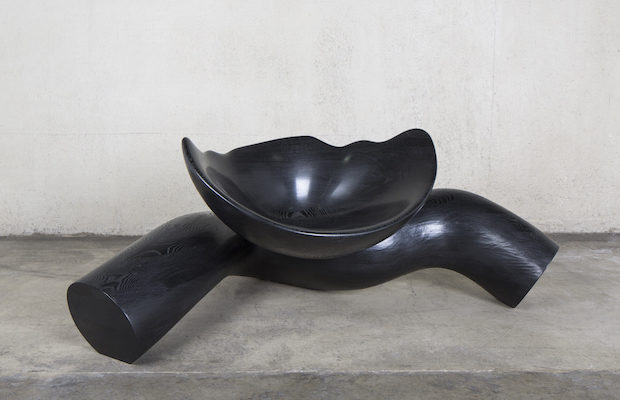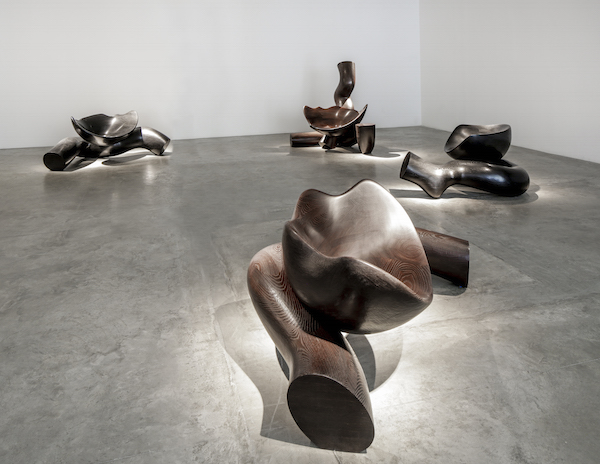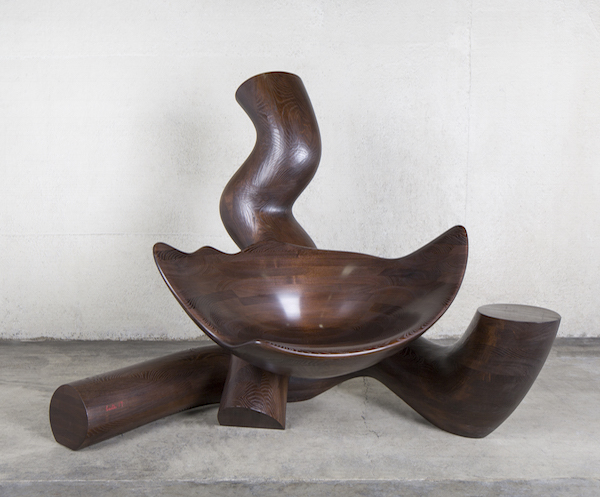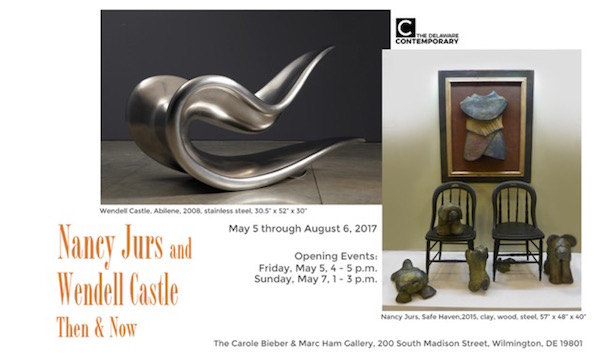 "Big Easy" by Wendell Castle, 2017. Stained ash. Courtesy of Friedman Benda and Wendell Castle, Photography by Dan Kukla
"Big Easy" by Wendell Castle, 2017. Stained ash. Courtesy of Friedman Benda and Wendell Castle, Photography by Dan Kukla
Exhibition
Musings on the latest Wendell Castle Show at Friedman Benda
Embracing Upheaval, the new Wendell Castle show at Friedman Benda, is not to be missed —and that’s a line I never expected to write. There may be only six works on display — five in stack laminate ash and one imposing two-part bronze, called Dante’s Heaven—but they offer a commanding vision of Castle’s ongoing fusion of art and design. They also provide as the title—which sounds like the name of an I-Ching hexagram—suggests, a triumphant response to the psychic challenges of the creative process and, possibly too, this politically trying American moment. Equally significant are the volumes the work speaks about the dynamic potential of an elder artist.

Dante’s Heaven by Wendell Castle, 2015. Bronze. Courtesy of Friedman Benda and Wendell Castle, Photography by Dan Kukla
At eighty-five, Wendell Castle is a master maker, rightly renowned for his superb craftsmanship and, at times, daring invention. His first pieces from 1958—barely functional, yet among my favorites—were assembled in part out of walnut gunstocks, and recall the bizarre skeletal forms in Yves Tanguy paintings. Trained as an artist, and possessing few woodworking skills, Castle fell into furniture-making by fluke and cheek, and followed on those striking early pieces with zoomorphic furnishings made either through a personally devised stack-laminate technique or by cast-molding fiberglass. That bodacious production put Castle at the forefront of the American studio furniture movement in the 1960s, and he’s remained a star player through its evolution into what’s most currently referred to as fine design. In fact, for the past decade or so, he has spearheaded the melding of digital technologies—3D scanning and modeling, along with computer-controlled milling—with traditional woodcraft—carving, rasping, and finishing—creating ever larger works, now verging on the monumental, at an age when most artists have long since put away their power tools.
Yet as original and au courant as Castle’s work has often been—his 1969 fiberglass Molar Armchair was a spot-on response to both pop art and the Italian anti-design movement—he has just as often recycled imagery using different materials or techniques or traveled down rabbit holes of frenzied creative research, like producing a seemingly endless array of wooden clocks or trompe l’oeil furnishings. For a time, too, in the 1980s and 1990s, Post-modern concerns nearly submerged his work. Of course that was a time when those in the design vanguard were experimenting with the ugly and eccentrically scaled in an effort to advance a new realm of expression. Yet rather than being bracingly fresh, Castle’s cacophonous chromatic palette and exaggerated botanical forms and textures appeared only cloyingly peculiar.

Courtesy of Friedman Benda and Wendell Castle, Photography by Dan Kukla
To my eye, Castle’s production only became compelling again when he started showing with Barry Friedman in 2008. At that gallery, which later became Friedman Benda, it appears Castle found the space and security to take a deep creative breath and reassess his path. And that led to a return to the organic formulations that had distinguished his early work, but now those shapes were more refined, articulate, and pure. He worked again in fiberglass, but this time elevated his designs with a selection of luxe finishes—gold or silver leaf or an automobile-grade iridescent urethane. He explored making biomorphic chairs and tables out of cast concrete and welded stainless steel. These limited-edition and one-off pieces were hotly collected, and soon attracted the interest of the then London-based Carpenters Workshop Gallery, exposing Castle to a larger and even more international collecting audience.
He continued to make stack-laminate seats and tables, now evocative of roots, sprouts, and tendrils, but stained the typically blonde ash wood with an ebony hue, endowing the pieces with a sober majesty.

Courtesy of Friedman Benda and Wendell Castle, Photography by Dan Kukla
Cast bronze works with gouged and etched surfaces came next, and these at long last demonstrated what a significant sculptor Castle is by linking him to a classical art-making tradition. In fact, Castle says he often thinks about the conundrums of sculptors of the past. The idea for Awakening, a massive stack laminate piece in the show that appears to be a huge seat-like pod carved out of the rough-hewn block adjoining it, apparently arose out of the way ancient sculptors carved a figure with a support at the feet, like a crudely carved stone, to stabilize it.

Hornet’s Nest by Wendell Castle, 2016. Stained ash. Courtesy of Friedman Benda and Wendell Castle, Photography by Dan Kukla
And that finally is what makes these latest pieces so exciting. They present Castle not as an artsy furniture maker, a role in which he previously lost his way, but as the abstract artist he truly is, crafting potent sculptures that invite physical engagement. Castle’s arrival at this lofty milestone is what makes this show such a must see, not to mention a remarkable life lesson about the creative path on which we all travel.
Editor’s Note: The Delaware Contemporary in Wilmington, Delaware, is also showing Wendell Castle’s work, but in a different –and equally historic—context, an exhibition shared with his artist wife, Nancy Jurs. The couple first showed jointly there in 1996, so this exhibition, entitled Then & Now: Wendell Castle & Nancy Jurs, runs through August 6.













